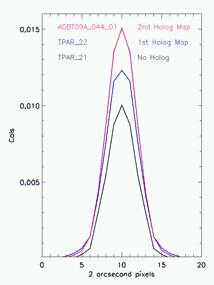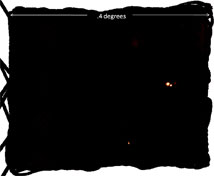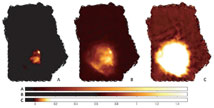Brian Mason, Simon Dicker & Phil Korngut for the MUSTANG Team

Figure 1: Radial profiles of Ceres, a primary MUSTANG calibrator, and a compact (<1") asteroid with a known thermodynamic temperature. These profiles were collected before holographic corrections, and after two versions of the holographic corrections derived by the PTCS team. The vertical axis is apparent source intensity in units of MUSTANG's internal noise calibration lamp; the x-axis is linear distance in 2 arcsecond pixels.
 Zoom
Zoom

Figure 2: Large-area (0.4 deg x 0.3 deg) map collected in 45 minutes during commissioning in January 2009. This map makes use of the GBT's Quadrant Detector to correct for feedarm pointing errors induced by the rapid scanning. The rms noise in these data, which were collected prior to the new holography corrections, is ~ 8 mJy.
 Zoom
Zoom

Figure 3: MUSTANG+GBT 90 GHz map of Orion on 3 color scales (Jy per 10" beam) emphasizing the dynamic range and sensitivity to extended structure that has been achieved. These maps resulted from Early Science observations in spring 2008.
 Zoom
Zoom
MUSTANG, a 64-pixel bolometer array and the GBT's first 90 GHz instrument, has been commissioned for science observations starting in February 2009. GBT data have confirmed that the MUSTANG optics upgrade has yielded the expected 35% increase in field-of-view (from 32 arcseconds square to 42 arcseconds square) and a 70% decrease in noise per detector.
In conjunction with improvements reported in the accompanying article by Todd Hunter and the PTCS group, MUSTANG is on track for the projected factor of three improvement in sensitivity over last season and has good prospects for further improvements in the near future.
Figure 1 shows cuts through maps of Ceres, a MUSTANG primary calibrator, before and after the application of holographic corrections. We have also tested rapid, large-area mapping techniques with good results (Figure 2). Images suitable for publication, or for analysis with other astronomical images, are produced through Bill Cotton's OBIT software package (see Figure 3). As of January 2009 MUSTANG has been fully integrated into the GBT control system, a milestone which represents the culmination of many months of hard work on the data acquisition and control software. Efforts to construct an improved detector array for the receiver are also underway.
Over 120 hours of science proposals have been accepted, with programs
targeting a variety of topics ranging from the Sunyaev-Zel'dovich
Effect in clusters to protoplanetary debris disks. Future calls for proposals will include MUSTANG.
For more information about MUSTANG see http://www.gb.nrao.edu/mustang/ and http://chile1.physics.upenn.edu/
gbtpublic/.

 Zoom
Zoom
